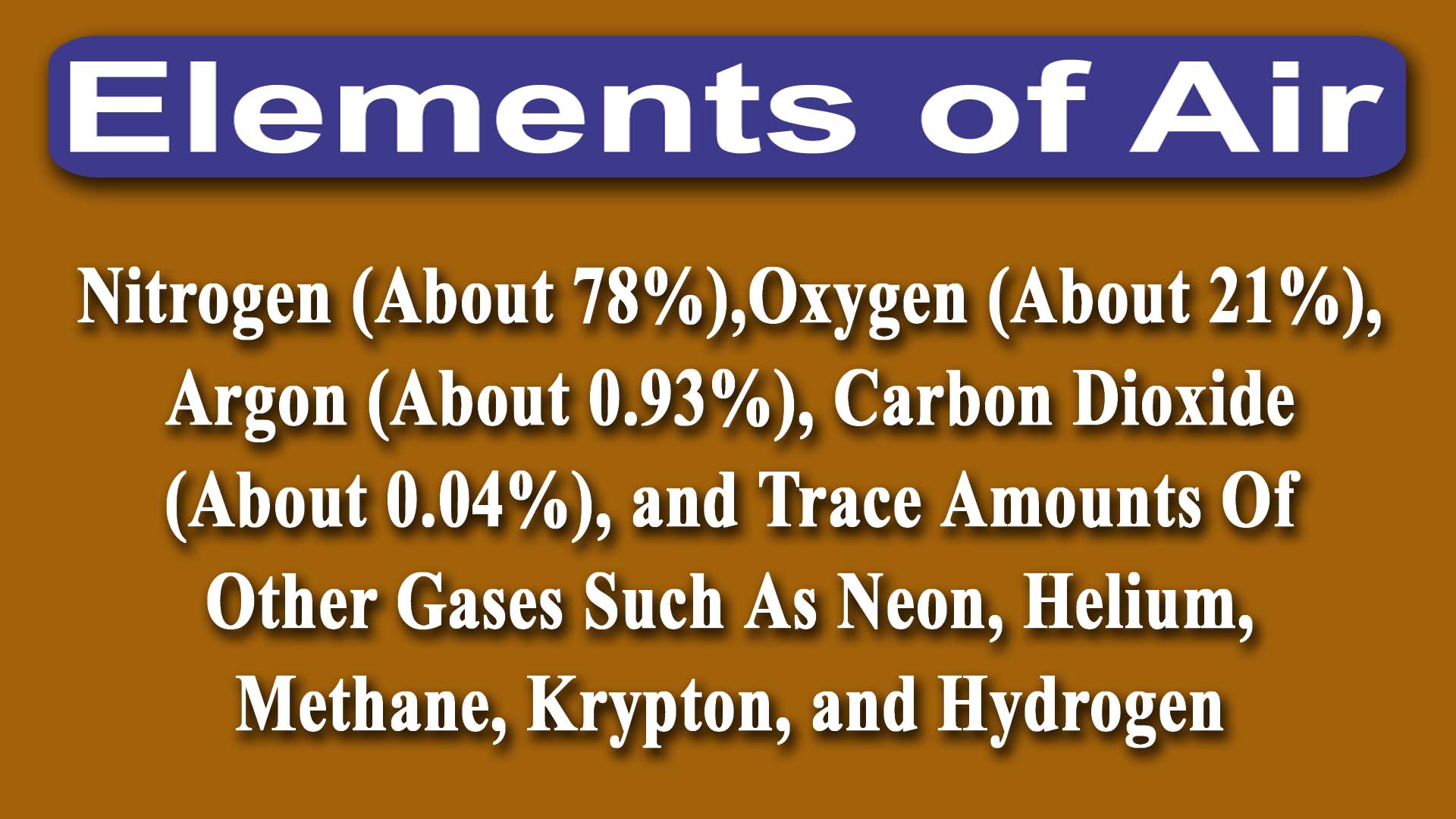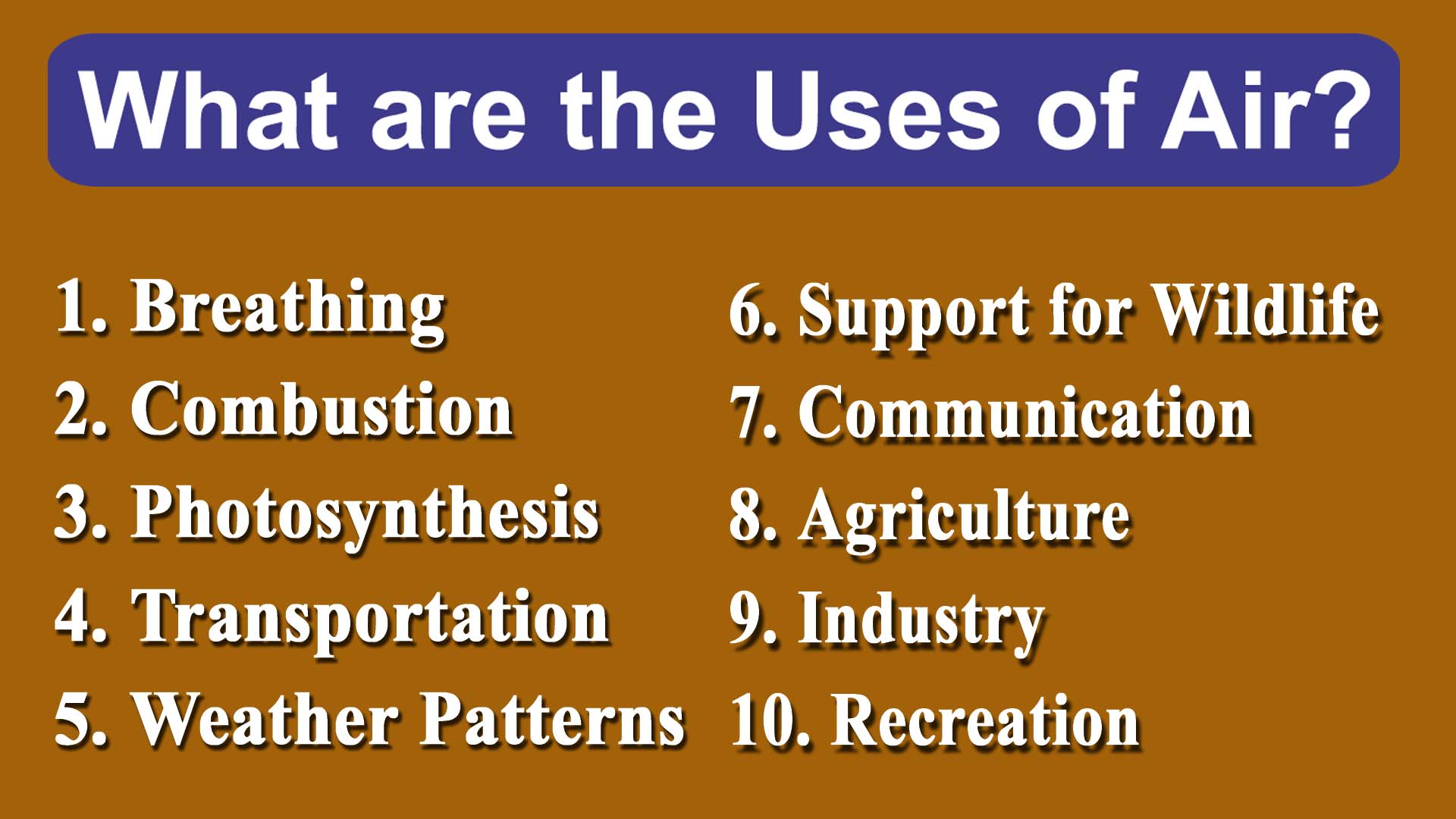 Detailed Air Facts for enhance knowledge
Detailed Air Facts for enhance knowledge
“Journey through the Science of Air, its components, Uses, Pollution Reason and Prevention”
Table of Contents:
1. What is Air in Science Definition?
2. What are the components of Air?
3. What are the Uses of Air?
4. What are the causes of Air Pollution?
5. What are the preventive steps to mitigate air pollution?
What is Air in Science Definition?
In science, air is a mixture of gases that make up Earth’s atmosphere. The primary components of air are nitrogen (about 78%), oxygen (about 21%), argon (about 0.93%), carbon dioxide (about 0.04%), and trace amounts of other gases such as neon, helium, methane, krypton, and hydrogen. Water vapor is also present in variable amounts.
The composition of air can vary slightly depending on factors such as location, altitude, and environmental conditions. Air is essential for life on Earth, as it provides the necessary gases for respiration and plays a crucial role in various atmospheric processes, including weather patterns and the greenhouse effect.
What are the components of Air?
Air is a mixture of gases that make up Earth’s atmosphere. The primary components of air include:

Components of Air – Gases of Atmosphere
- Nitrogen (N2): Nitrogen makes up the largest portion of Earth’s atmosphere, accounting for about 78% of the air we breathe.
- Oxygen (O2): Oxygen is the second most abundant gas in the atmosphere, making up approximately 21% of the air. It is essential for the respiration of living organisms.
- Argon (Ar): Argon is a noble gas and makes up about 0.93% of the atmosphere. It is inert and does not readily participate in chemical reactions.
- Carbon Dioxide (CO2): Carbon dioxide is a trace gas, making up about 0.04% of the atmosphere. While it is a small percentage, it plays a crucial role in the Earth’s greenhouse effect and the regulation of climate.
- Neon (Ne), Helium (He), Krypton (Kr), and Xenon (Xe): These are other noble gases present in trace amounts in the atmosphere.
- Trace Gases: Various other gases are present in extremely small quantities, including methane (CH4), ozone (O3), hydrogen (H2), and water vapor (H2O), among others.
The composition of the atmosphere can vary slightly due to factors such as location, altitude, and human activities. Overall, these gases create the air we breathe and play vital roles in supporting life on Earth.
What are the Uses of Air?
Air is essential for various purposes and plays a crucial role in supporting life on Earth. Here are some of the key uses of air:

What are the Uses of Air
- Breathing: The most vital use of air is for respiration by humans, animals, and many other organisms. Oxygen from the air is essential for the process of cellular respiration, providing the energy needed for various life processes.
- Combustion: Air is necessary for the process of combustion, which includes burning fuels. The oxygen in the air supports the chemical reactions that release energy in the form of heat and light, used for cooking, heating, and various industrial processes.
- Photosynthesis: Plants use carbon dioxide from the air in the process of photosynthesis, where they convert sunlight into energy and produce oxygen as a byproduct. This process is vital for the growth of plants and the production of oxygen in the atmosphere.
- Transportation: Air is used as a medium for transportation, including air travel. Airplanes rely on the properties of air, such as lift, to stay airborne and move from one place to another.
- Weather Patterns: Air plays a significant role in shaping weather patterns. The movement and interaction of air masses create winds, precipitation, and other weather phenomena that influence climate and ecosystems.
- Support for Wildlife: Air provides habitats for various flying organisms, such as birds and insects. It also influences the distribution of species and contributes to ecological balance.
- Communication: Sound waves travel through the air, enabling communication. Speech, music, and other forms of auditory communication depend on the transmission of sound through the air medium.
- Agriculture: Air is essential for the well-being of plants and crops. Adequate air circulation is crucial for preventing diseases, and carbon dioxide from the air is used by plants during photosynthesis.
- Industry: Many industrial processes rely on air, including pneumatic systems, where compressed air is used for various applications such as operating machinery and tools.
- Recreation: Air is utilized for various recreational activities, such as flying kites, paragliding, and other air sports. It also contributes to the enjoyment of outdoor activities by providing a fresh and breathable environment.
In summary, air serves a multitude of essential functions, from sustaining life through respiration and photosynthesis to supporting various human activities and maintaining ecological balance.
What are the causes of Air Pollution?
Air pollution is caused by the release of various pollutants into the Earth’s atmosphere. These pollutants can be emitted from natural sources or human activities. The main causes of air pollution include:

Air Pollution Components
- Emissions from Vehicles: Combustion engines in cars, trucks, and other vehicles release pollutants such as carbon monoxide, nitrogen oxides, particulate matter, and volatile organic compounds into the air.
- Industrial Activities: Factories and industrial facilities emit pollutants like sulfur dioxide, nitrogen oxides, particulate matter, and various chemicals. Industrial processes, especially those involving combustion and chemical production, contribute significantly to air pollution.
- Power Plants: The burning of fossil fuels (coal, oil, and natural gas) in power plants releases pollutants like sulfur dioxide, nitrogen oxides, carbon dioxide, and particulate matter into the air.
- Agricultural Practices: Agricultural activities can release pollutants such as ammonia, methane, and particulate matter. The use of fertilizers and pesticides also contributes to air pollution.
- Deforestation and Biomass Burning: The clearing of forests through burning and other means releases large amounts of particulate matter, carbon monoxide, and other pollutants into the air.
- Waste Management: Improper disposal and burning of solid waste, as well as open dumping of waste, contribute to air pollution. Burning of waste materials releases harmful substances into the atmosphere.
- Construction Activities: Construction sites can generate dust and particulate matter, contributing to local air pollution. The use of heavy machinery and equipment also releases pollutants.
- Household Activities: Burning solid fuels for cooking and heating in households, especially in developing countries, can release pollutants like particulate matter and carbon monoxide into the air.
- Natural Sources: While human activities are the primary contributors to air pollution, natural sources such as wildfires, volcanic eruptions, and dust storms can also release pollutants into the atmosphere.
- Chemical Solvents and Products: The use of certain chemical solvents in various industrial processes and the release of pollutants from consumer products can contribute to air pollution.
Efforts to reduce air pollution often focus on mitigating emissions from these sources through regulatory measures, technological advancements, and changes in behavior and consumption patterns.
What Are The Preventive Steps To Mitigate Air Pollution?
Mitigating air pollution requires a combination of individual actions, community efforts, and government policies. Here are some preventive steps to help mitigate air pollution:

What Are The Preventive Steps To Mitigate Air Pollution
- Reduce Vehicle Emissions:
- Use public transportation, carpool, or bike to reduce the number of individual vehicle emissions.
- Choose fuel-efficient vehicles and maintain them regularly.
- Support and use electric or hybrid vehicles.
- Promote Sustainable Transportation:
- Develop and expand public transportation systems.
- Encourage walking and cycling by creating pedestrian and cyclist-friendly infrastructure.
- Improve Industrial Practices:
- Implement and enforce stricter emission standards for industries.
- Encourage industries to adopt cleaner technologies and practices.
- Use Renewable Energy:
- Transition to renewable energy sources such as solar, wind, and hydro power.
- Support policies that promote the use of clean energy in households and industries.
- Reduce Household Pollution:
- Use energy-efficient appliances to reduce household emissions.
- Properly maintain and regularly service heating and cooling systems.
- Avoid burning solid fuels indoors and use cleaner alternatives.
- Plant Trees and Maintain Green Spaces:
- Trees and plants help absorb pollutants and improve air quality.
- Encourage tree planting initiatives and the maintenance of green spaces in urban areas.
- Waste Management:
- Implement proper waste management practices to reduce open burning and landfill emissions.
- Promote recycling and the proper disposal of hazardous materials.
- Regulate Agricultural Practices:
- Implement sustainable agricultural practices to reduce air pollution from pesticides and fertilizers.
- Encourage the use of organic farming methods.
- Raise Awareness:
- Educate the public about the causes and effects of air pollution.
- Promote awareness of individual actions that can contribute to reducing pollution.
- Advocate for Policy Changes:
- Support and advocate for stricter environmental regulations and policies.
- Encourage the development and enforcement of air quality standards.
- Monitor and Research:
- Invest in air quality monitoring systems to track pollution levels.
- Support research on the sources and impacts of air pollution to inform effective mitigation strategies.
- International Cooperation:
- Collaborate with other countries to address cross-border pollution issues.
- Share information and best practices for mitigating air pollution.
Addressing air pollution requires a comprehensive and collaborative approach involving individuals, communities, industries, and governments at various levels.
air elements air Pollution air pollution prevention and hydrogen and trace amounts of other gases such as neon argon Breath of Life carbon dioxide causes of air pollution components of air components of air include Earth's atmosphere greenhouse effect helium krypton methane nitrogen oxygen preventive measures to mitigate air pollution Science of Air Uses of air Wonders of Air


 Detailed Air Facts for enhance knowledge
Detailed Air Facts for enhance knowledge



